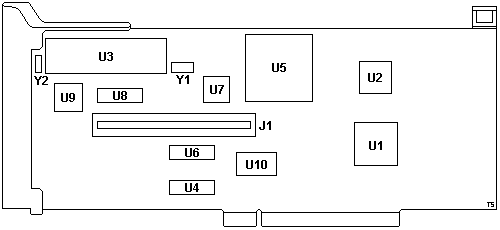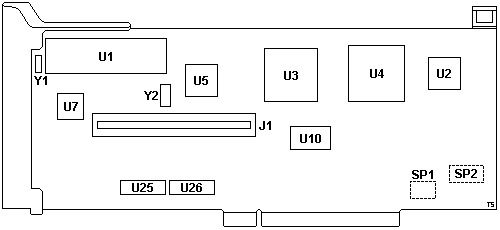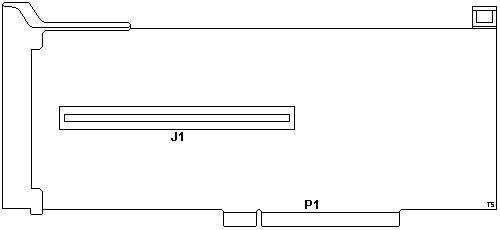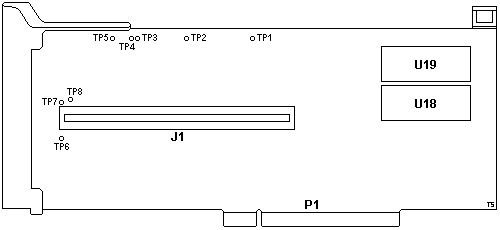|
188-082 IBM PS/2 60MB FIXED DISK DRIVE
60mbbuff.exe PS/2 60MB Fixed Disk Buffer Test v1.10
60mfdisk.com 60MB Fixed Disk Upg for M50-021 v1.00
Procom MC Pira IDE
Disk Drives
Early 8550-021 ST-506 Adapter
Later 8550 ST-506 Adapter
Bare 8550 DBA-ESDI Adapter
8550 DBA-ESDI Adapter w/ ROM
50z Riser ROMs
8550 Drive Controllers
Is the IBM Integrated HD Adapter ESDI?
Disk Drives
8550-021 - 20MB HD (uses 72X8505/90X8642)
8550-031,-061 - 160MB (used 90X9441, no chips) 50Z
8550-032 - 30MB 50Z
8550-061 - 60MB 50Z
The Pocket Ref. says:
| System |
FRU |
Size |
Interface |
IBM |
| 8550 |
72X8522 |
20 MB |
ST506 |
WD325N |
| 8550Z |
6128287 |
30 MB |
ST506 "like" |
WD336RT |
| 6128294 |
30 MB |
ESDI "like" |
WD387 |
| 8570 |
56F8895 |
160 MB |
ESDI "like" |
WD380S |
Early ST-506 Adapter FRU P/N 90X8070, "6127873B"
![Front [P]](/other/img/photo.gif)
![Back [P]](/other/img/photo.gif) |
|
![Front (alt) [P]](/other/img/photo.gif)
![Back (alt) [P]](/other/img/photo.gif)
Shipped with 8550-021. Equivalent to MFM Adapter 72X8540.

J1 50-pin edge connector for HDD
U1 Unknown IC
U3 Intel P8051AH µcontroller "5960896"
U4 Motorola MC3486P line recv.
U5 1700824 (metal can)
U6 AMD AM26LS31PC line driver
|
U7 1700874 (TI CF60025FN)
U8 TI 1700754
U9 6301209 (metal can)
U10 Hitachi HM6116LFP-3 2Kx8 SRAM
Y1 20.017? MHz xtal (for U7)
Y2 12.0? MHz xtal (for U3)
|
Later ST-506 Adapter FRU P/N 90X8642, "6127881B"
![Front [P]](/other/img/photo.gif)
![Back [P]](/other/img/photo.gif) |
|
![Front (alt) [P]](/other/img/photo.gif)
![Back (alt) [P]](/other/img/photo.gif) |
|
![Front (alt 2) [P]](/other/img/photo.gif)
Equivalent to MFM Adapter 90X8643.

Dave Beem says:
Apparently it is a different drive (50-pin edge connector) than
the 20 MB the Model 25/30 (44-pin) had. The Model 25/30 type also had a 30 MB
brother that ran on the 286 version of those PS/2s. On the Model 50 the 20Mb
was the only ST-506 drive type.
Bare DBA-ESDI Adapter FRU P/N 90X9441, P/N 90X9416
![Front [P]](/other/img/photo.gif)

J1 DBA-ESDI connector
P1 MCA edge contacts
The PCB is completely empty otherwise and acts only as a passive
interconnect.
David Beem says:
90X9441 is ESDI. There are two circuit board variants of this,
with no discernible differences: Circuit board 15F8434 has silkscreen outlines
(not populated) for two capacitors & wider power runs than the 90X9354
circuit board.
DBA-ESDI Adapter w/ ROM FRU P/N 90X9571, P/N 15F6993, 90X9570
![Front [P]](/other/img/photo.gif)
![Back [P]](/other/img/photo.gif) |
|
![Front (alt) [P]](/other/img/photo.gif)
Used in 8550-021 w/ 60 MB hard disk upgrade.

J1 DBA-ESDI connector
P1 MCA edge contacts
TP1-8 Test points
|
U18 BIOS 15F6994 (Even)
U19 BIOS 15F6995 (Odd)
|
U18, U19 D2764A-2 64K (8Kx8) 180 ns 28-pin PROM
50z Riser ROMs
Dr Jim delivered the twins:
I was able to remove the EPROMs with minimal damage but it was a
PITA. Wouldn't use them in sockets, reliability might be an issue. I see good
text in the code but of course I can't guarantee there isn't any random bit
rot. Should be good though.
15F6994_U18.BIN U18 Even 15F6994
15F6995_U19.BIN U19 Odd 15F6995
Per Mueller says:
"In response to user complaints about the storage capacity of the
original 20M Model 50, IBM offers the PS/2 60M hard disk drive as an upgrade
option. You can install this drive by replacing the existing 20M [ST-506] hard
disk in the PS/2 Model 50 (8550-021) or 30M [ESDI] in the Model 50 Z
(8550-031).
No trade-in is available for the earlier drive. This drive provides 60M of
storage and a faster access time of 27 ms. The replacement adapter card
required for the 50-021 is included [but is already there on the 50-031]."
8550 Drive Controllers
(from Peter H. Wendt)
There are 3 risers from IBM:
- Bare ESDI riser for the Mod. 50Z to be used with the 72-pin card-edge
drives. Passive. Does nothing but guiding signals.
- MFM controller for the 8550-021 with the "narrow" card-edge slot for the
20MB MFM drive. ID is DFFD, just like for the full length Mod. 60/80 MFM
controller.
- ESDI upgrade riser, with the 72-pin card edge slot for the drive and some
glue logic to make drive addressing possible, since the original Mod.50 lacks
the ESDI code in the machine BIOS. Controller ID is also DF9F, which is that of
the attached drive, which actually *is* a MCA controller card + drive mechanism
in one. Back then ESDI was a big thing and AT only knew MFM (not even RLL). The
early Mod. 50 BIOS is largely that of the AT...
In addition I saw a 5.25" FDD controller riser (RFI ? Long gone), a variant
of the ARCO IDE card (without rear bezel and handle), a similar thing from
Procom for a 3.5" drive with a special sled (IDE most likely), a QIC tape
adapter (Borsu or Iomega - can't recall), which feds a flat ribbon cable
out at the rear. Unit was a bulky 5.25" drive with power supply, fan and
impressive power switch. And another tape adapter which operated with a floppy
streamer in the second FDD bay. All these adapters were for the 50Z only, since
that one did not need an extra HD controller - unlike the original -021
(non-Z).
Is the IBM Integrated HD Adapter an ESDI Controller?
From Peter:
First off: The "IBM integrated harddisk adapter" (Card-ID DF9F) as
it can be found in 50Z, 55SX, 70 and P70 is not a real ESDI drive. It is more
or less technically an MFM RLL 2.7 drive - but combined with a MCA harddisk
adapter in one physical unit. The "ESDI or not misunderstandment" is caused by
the PS/2 BIOS.
They (IBM) treated the drive as ESDI, because back in those days the MFM
harddisk standard was limited to 17 sectors per track (and still is for pure
Non-RLL MFM drives) and while the "modern drives" used to be smaller and use
lesser platters and -therefore- lesser heads it was easier to translate the
physical geometry with e.g. 929 cylinders, 56 sectors and 4 heads into a scheme
with 64 heads, 32 sectors and "downscale" the number of cylinders
accordingly.
The above example (929 x 56 x 4) would result in 208.096 data blocks á 512
bytes = 106.545.152 bytes. The translation into the 64/32 ESDI scheme would
result in the more handy 101 cylinders ... by cutting down the total capacity
to 105.906.176 bytes total. However the values 101 cylinders, 64 heads and 32
sectors give a better match into the old XT/AT controller scheme - particularly
the cylinder register was -according to the basic WD1007 controller- the
problem. It could not hold values over 1.024 ... the ESDI translation in the
BIOS opened a more handy way to handle bigger drives up to 1GB IIRC.
So after all the "ESDI" in the desktops using the integrated harddisk thingy
is only imaginary. The towers (60 and 80) used "Real" ESDI controllers and
harddisks.
Secondly the DF9F HD / controller combo was primarily designed as "single
device". The later @DF9F.ADF allowed to set one as "primary" and one as
"secondary". But as far as I know this has been included to match an early
draft of the PS/2 Mod. 90 hardware... which *had* two integrated harddisk
controller ports at the front end of the sysboard. These however had been made
non-functional in the later platform BIOSes and don't work. I have played
around with them in the early 90s but found no clue to get them working with
any Type 1 - 3 platform. As well as Alfred Arnold tried recently - don't know
if he gave up yet.
I hadn't been that desperate to try installing the 386DX-20 (Type-0)
platform in my 8590 and see if I get the front drivebays going with that.
Due to the lack of appropriate connectors none of the PS/2 machines support
two integrated harddisk adapters. These *are* MCA connectors. The 72-pin layout
of these drives is basically a slightly stripped-down 16-bit MCA connector. And
the planar ADF for e.g. a Mod. 55SX says "4 slots" where the Slots 1 - 3 are
for expansion cards and Slot 4 is at the end of the riser card - extended with
a flat-ribbon cable over and down to the harddisk.
And - No - you cannot just crimp another 72-pin connector in that cable.
There are signals that select the slot number - and that for this "cable port"
is fixed set to Slot 4... so any other connector on that cable would signal
"Slot 4" to the sysboard. It is -as said- "stripped down"... means: apart from
some DC- and GND-wires also "other unimportant signals" are not passed over to
the HD-connector.
|